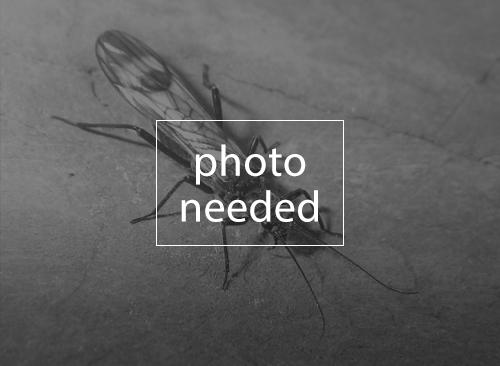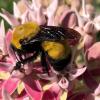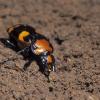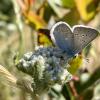
Hylaeus akoko is a large bee endemic to the island of Hawaii in Hawaii. It is closely related to the common wet forest species H. fuscipennis and H. pubescens, differing by the presence of facial marks. It was first collected in 2002, and is still known from only a few specimens from a single locality.
Males
Black; clypeus with small irregular ivory marks near the apex (possibly sometimes absent), scape broadly ivory on the lateral margin, fore and mid tibiae and femora orange anteriorly, hind tibia and all basitarsi ivory for their entire length. Punctation of abdomen distinct.
Females
Unknown; may be indistinguishable from H. fuscipennis. Hylaeus akoko is larger and more robust than most Hawaiian species. It is a member of a group of species with distinct punctation of the abdomen, including H. anomalus and H. satelles. It is most similar to H. pubescens of the island of Hawaii, which has dense reddish hairs on the apex of the abdomen and a distinctly humped T2; and H. fuscipennis, which differs in the genitalia and is found on Maui Nui and Oahu. Both of these species lack facial marks and orange on the legs and are found in wet to mesic forest, while H. akoko has facial marks and has only been found in mesic forest.
Taxonomic status
Hylaeus akoko was first collected in 2002 and described in Daly and Magnacca (2003).
So far as known, H. akoko inhabits mesic forests. All collections so far have come from Chamaesyce olowaluana (akoko) trees.
Hylaeus akoko is apparently restricted to me sic forest in the Puu Waawaa area at an elevation of approximately 4100 ft. Less than 10 specimens have been collected.
Xerces Red List Status: Critically Imperiled
Other Rankings:
Canada – Species at Risk Act: N/A
Canada – provincial status: N/A
Mexico: N/A
USA – Endangered Species Act: None
USA – state status: None
NatureServe: GNR
IUCN Red List: N/Antent here.
This species is extremely rare; it is found in very low numbers and has a very narrow range.
The rarity of H. akoko and lack of knowledge about its requirements make it difficult to assess threats. In general, Chamaesyce olowaluana appears to support a much larger bee fauna than is found in nearby forest. It is also extremely vulnerable to grazing by sheep, which prevents reproduction. As a result, there are relatively few trees in the Puu Waawaa area. Dependence on C. olowaluana may therefore be an important factor in its distribution. Although C. olowaluana is found scattered throughout the area from Puu Waawaa to the Humuula saddle, the area where H. akoko was found is transitional between dry and mesic forest, a relatively rare habitat. Lack of nest sites due to declines in the populations of wood-boring Plagithmysus longhorn beetles may also be a factor, but has not been investigated.
Currently, the top priority is to identify extant populations and document the continued existence of the species. All areas where H. akoko is likely to be found are protected under the auspices of the State of Hawaii or the U.S. Army, though they may not be actively managed for habitat conservation. The trees that H. akoko were collected on lie just outside a sheep fence; including them in the fenced area and/or planting C. olowaluana within the exclosure would help greatly.
Research is needed in order to identify reasons for rarity, determine dependence on C. olowaluana, and locate new populations.
Daly, H. V., and K. N. Magnacca. 2003. Insects of Hawaii, Vol. 17: Hawaiian Hylaeus (Nesoprosopis) Bees (Hymenoptera: Apoidea). University of Hawaii Press, Honolulu. 234 pp.
Citation
Magnacca, K. N. 2005. Species Profile: Hylaeus akoko. In Shepherd, M.D., D.M. Vaughan, and S. H. Black (Eds). Red List of Pollinator Insects of North America. CD-ROM Version 1 (May 2005). Portland, OR: The Xerces Society for Invertebrate Conservation.
Profile prepared by Karl Magnacca, USGS-BRD, Kilauea Field Station





